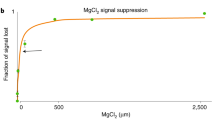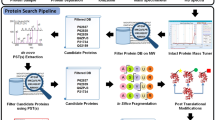Abstract
Top-down mass spectrometry is an emerging technology which strives to preserve the post-translationally modified forms of proteins present in vivo by measuring them intact, rather than measuring peptides produced from them by proteolysis. The top-down technology is beginning to capture the interest of biologists and mass spectrometrists alike, with a main goal of deciphering interaction networks operative in cellular pathways. Here we outline recent approaches and applications of top-down mass spectrometry as well as an outlook for its future.
This is a preview of subscription content, access via your institution
Access options
Subscribe to this journal
Receive 12 print issues and online access
$259.00 per year
only $21.58 per issue
Buy this article
- Purchase on Springer Link
- Instant access to full article PDF
Prices may be subject to local taxes which are calculated during checkout



Similar content being viewed by others
References
Kelleher, N.L. et al. Top down versus bottom up protein characterization by tandem high-resolution mass spectrometry. J. Am. Chem. Soc. 121, 806–812 (1999).
McLafferty, F.W., Fridriksson, E.K., Horn, D.M., Lewis, M.A. & Zubarev, R.A. Biochemistry: biomolecule mass spectrometry. Science 284, 1289–1290 (1999).
Reid, G.E. & McLuckey, S.A. 'Top down' protein characterization via tandem mass spectrometry. J. Mass Spectrom. 37, 663–675 (2002).
Kelleher, N.L. Top down proteomics. Anal. Chem. 76, 197A–203A (2004).
Bogdanov, B. & Smith, R.D. Proteomics by FTICR mass spectrometry: top down and bottom up. Mass Spectrom. Rev. 24, 168–200 (2005).
McLafferty, F.W. High resolution tandem FT mass spectrometry above 10 kDa. Acc. Chem. Res. 27, 379–386 (1994).
Kelleher, N.L., Costello, C.A., Begley, T.P. & McLafferty, F.W. Thiaminase I (42 kDa) heterogeneity, sequence refinement, and active site location from high-resolution tandem mass spectrometry. J. Am. Soc. Mass Spectrom. 6, 981–984 (1995).
Meng, F. et al. Processing complex mixtures of intact proteins for direct analysis by mass spectrometry. Anal. Chem. 74, 2923–2929 (2002).
Meng, F. et al. Molecular-level description of proteins from Saccharomyces cerevisiae using quadrupole FT hybrid mass spectrometry for top down proteomics. Anal. Chem. 76, 2852–2858 (2004).
Patrie, S.M. et al. Top down mass spectrometry of <60 kDa proteins from Methanosarcina acetivorans using quadrupole FTMS with automated octapole collisionally activated dissociation. Mol. Cell. Proteomics 5, 14–25 (2006).
Pesavento, J.J., Mizzen, C.A. & Kelleher, N.L. Quantitative analysis of modified proteins and their positional isomers by tandem mass spectrometry: human histone H4. Anal. Chem. 78, 4271–4280 (2006).
Zabrouskov, V. et al. Stepwise deamidation of ribonuclease A at five sites determined by top down mass spectrometry. Biochemistry 45, 987–992 (2006).
Reiber, D.C., Grover, T.A. & Brown, R.S. Identifying proteins using matrix-assisted laser desorption/ionization in-source fragmentation data combined with database searching. Anal. Chem. 70, 673–683 (1998).
Ogorzalek Loo, R.R. et al. Virtual 2-D gel electrophoresis: visualization and analysis of the E. coli proteome by mass spectrometry. Anal. Chem. 73, 4063–4070 (2001).
Johnson, J.R., Meng, F., Forbes, A.J., Cargile, B.J. & Kelleher, N.L. Fourier-transform mass spectrometry for automated fragmentation and identification of 5–20 kDa proteins in mixtures. Electrophoresis 23, 3217–3223 (2002).
Sharma, S. et al. Proteomic profiling of intact protein using WAX-RPLC 2-D separations and FTICR mass spectrometry. J. Proteome Res. 6, 602–610 (2007).
Zhou, F. & Johnston, M.V. Protein profiling by capillary isoelectric focusing, reversed-phase liquid chromatography, and mass spectrometry. Electrophoresis 26, 1383–1388 (2005).
Chong, B.E., Yan, F., Lubman, D.M. & Miller, F.R. Chromatofocusing nonporous reversed-phase high-performance liquid chromatography/electrospray ionization time-of-flight mass spectrometry of proteins from human breast cancer whole cell lysates: a novel two-dimensional liquid chromatography/mass spectrometry method. Rapid Commun. Mass Spectrom. 15, 291–296 (2001).
Zhao, J. et al. Proteomic analysis of estrogen response of premalignant human breast cells using a 2-D liquid separation/mass mapping technique. Proteomics 6, 3847–3861 (2006).
Nemeth-Cawley, J.F. & Rouse, J.C. Identification and sequencing analysis of intact proteins via collision-induced dissociation and quadrupole time-of-flight mass spectrometry. J. Mass Spectrom. 37, 270–282 (2002).
Roth, M.J. et al. Precise and parallel characterization of coding polymorphisms, alternative splicing and modifications in human proteins by mass spectrometry. Mol. Cell. Proteomics 4, 1002–1008 (2005).
Hu, Q. et al. The Orbitrap: a new mass spectrometer. J. Mass Spectrom. 40, 430–443 (2005).
Scigelova, M. & Makarov, A. Orbitrap mass analyzer - overview and applications in proteomics. Proteomics 6 (suppl. 2), 16–21 (2006).
Zubarev, R., Kelleher, N. & McLafferty, F. Electron capture dissociation of multiply charged protein cations. A nonergodic process. J. Am. Chem. Soc. 120, 3265–3266 (1998).
Syka, J.E., Coon, J.J., Schroeder, M.J., Shabanowitz, J. & Hunt, D.F. Peptide and protein sequence analysis by electron transfer dissociation mass spectrometry. Proc. Natl. Acad. Sci. USA 101, 9528–9533 (2004).
Coon, J.J. et al. Protein identification using sequential ion/ion reaction and tandem mass spectrometry. Proc. Natl. Acad. Sci. USA 102, 9463–9468 (2005).
Reid, G.E., Shang, H., Hogan, J.M., Lee, G.U. & McLuckey, S.A. Gas-phase concentration, purification, and identification of whole proteins from complex mixtures. J. Am. Chem. Soc. 124, 7353–7362 (2002).
Cargile, B.J., McLuckey, S.A. & Stephenson, J.L., Jr. Identification of bacteriophage MS2 coat protein from E. coli lysates via ion trap collisional activation of intact protein ions. Anal. Chem. 73, 1277–1285 (2001).
Chi, A., Bai, D.L., Geer, L.Y., Shabanowitz, J. & Hunt, D.F. Analysis of intact proteins on a chromatographic time scale by electron transfer dissociation tandem mass spectrometry. Int. J. Mass Spectrom. 259, 197–203 (2007).
Amunugama, R., Hogan, J.M., Newton, K.A. & McLuckey, S.A. Whole protein dissociation in a quadrupole ion trap: identification of an a priori unknown modified protein. Anal. Chem. 76, 720–727 (2004).
Kelleher, N.L. et al. Localization of labile post-translational modifications by electron capture dissociation: the case of γ-carboxyglutamic acid. Anal. Chem. 71, 4250–4253 (1999).
Meng, F. et al. Informatics and multiplexing of intact protein identification in bacteria and the archaea. Nat. Biotechnol. 19, 952–957 (2001).
Reid, G.E., Stephenson, J.L., Jr. & McLuckey, S.A. Tandem mass spectrometry of ribonuclease A and B: N-linked glycosylation site analysis of whole protein ions. Anal. Chem. 74, 577–583 (2002).
Han, X., Jin, M., Breuker, K. & McLafferty, F.W. Extending top down mass spectrometry to proteins with masses greater than 200 kilodaltons. Science 314, 109–112 (2006).
Chi, A. et al. Analysis of phosphorylation sites on proteins from Saccharomyces cerevisiae by electron transfer dissociation (ETD) mass spectrometry. Proc. Natl. Acad. Sci. USA 104, 2193–2198 (2007).
Taylor, G.K. et al. Web and database software for identification of intact proteins using top down mass spectrometry. Anal. Chem. 75, 4081–4086 (2003).
LeDuc, R.D. et al. ProSight PTM: an integrated environment for protein identification and characterization by top-down mass spectrometry. Nucleic Acids Res. [online] 32, W340–W345 (2004).
Pesavento, J.J., Kim, Y.B., Taylor, G.K. & Kelleher, N.L. Shotgun annotation of histone modifications: a new approach for streamlined characterization of proteins by top down mass spectrometry. J. Am. Chem. Soc. 126, 3386–3387 (2004).
Boyne, M.T., II, Pesavento, J.J., Mizzen, C.A. & Kelleher, N.L. Precise characterization of human histones in the H2A gene family by top down mass spectrometry. J. Proteome Res. 5, 248–253 (2006).
Siuti, N., Roth, M.J., Mizzen, C.A., Kelleher, N.L. & Pesavento, J.J. Gene-specific characterization of human histone H2B by electron capture dissociation. J. Proteome Res. 5, 233–239 (2006).
Medzihradszky, K.F. et al. Characterization of Tetrahymena histone H2B variants and posttranslational populations by electron capture dissociation (ECD) Fourier transform ion cyclotron mass spectrometry (FT-ICR MS). Mol. Cell. Proteomics 3, 872–886 (2004).
Thomas, C.E., Kelleher, N.L. & Mizzen, C.A. Mass spectrometric characterization of human histone H3: a bird's eye view. J. Proteome Res. 5, 240–247 (2006).
Garcia, B.A., Pesavento, J.J., Mizzen, C.A. & Kelleher, N.L. Pervasive combinatorial modification of histone H3 in human cells. Nat. Methods 4, 487–489 (2007).
Taverna, S.D. et al. Long-distance combinatorial linkage between methylation and acetylation on histone H3 N termini. Proc. Natl. Acad. Sci. USA 104, 2086–2091 (2007).
Whitelegge, J., Halgand, F., Souda, P. & Zabrouskov, V. Top down mass spectrometry of integral membrane proteins. Expert Rev. Proteomics 3, 585–596 (2006).
Gomez, S.M. et al. Transit peptide cleavage sites of integral thylakoid membrane proteins. Mol. Cell. Proteomics 2, 1068–1085 (2003).
Macek, B., Waanders, L.F., Olsen, J.V. & Mann, M. Top down protein sequencing and MS3 on a hybrid linear quadrupole ion trap-Orbitrap mass spectrometer. Mol. Cell. Proteomics 5, 949–958 (2006).
Zabrouskov, V., Senko, M.W., Du, Y., LeDuc, R.D. & Kelleher, N.L. New and automated MSn approaches for top down identification of modified proteins. J. Am. Soc. Mass Spectrom. 16, 2027–2038 (2005).
Parks, B.A. et al. An online method for top down proteomics using an LTQ-FTICR. Anal. Chem. (in the press).
Acknowledgements
Without funding from the University of Illinois, the National Institutes of Health (GM 067193), the Packard Foundation, the Alfred P. Sloan Foundation, the Dreyfus Foundation, the Roy J. Carver Charitable Trust (04-76) and the Institute of Genomic Biology, this review would not have been possible. All these sources of support have driven the advance of top-down proteomics at the University of Illinois over the past seven years.
Author information
Authors and Affiliations
Ethics declarations
Competing interests
Thermo Fisher holds the licensing rights for distribution of ProSightPC software.
ProSight is available publicly as ProSight PTM (https://prosightptm.scs.uiuc.edu) or through Thermo Fisher as ProSightPC.
Rights and permissions
About this article
Cite this article
Siuti, N., Kelleher, N. Decoding protein modifications using top-down mass spectrometry. Nat Methods 4, 817–821 (2007). https://doi.org/10.1038/nmeth1097
Published:
Issue Date:
DOI: https://doi.org/10.1038/nmeth1097
This article is cited by
-
Study of β1-transferrin and β2-transferrin using microprobe-capture in-emitter elution and high-resolution mass spectrometry
Scientific Reports (2023)
-
DeepFLR facilitates false localization rate control in phosphoproteomics
Nature Communications (2023)
-
Sampling the proteome by emerging single-molecule and mass spectrometry methods
Nature Methods (2023)
-
Progress in Top-Down LC-MS Analysis of Antibodies: Review
Biotechnology and Bioprocess Engineering (2023)
-
A photocleavable surfactant for top-down proteomics
Nature Methods (2019)



